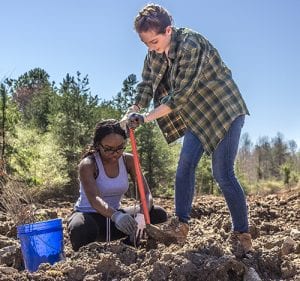In December of 2016, TACF renewed its Memorandum of Understanding (MOU) with the U.S. Department of the Interior’s Office of Surface Mining Reclamation and Enforcement (OSMRE). The singed memorandum promotes the reforestation of surface mines using scientifically developed techniques, known collectively as the Forestry Reclamation Approach (FRA), and promotes American chestnut reintroduction trials on surface mined lands across Appalachia. Since the first signing of the MOU in 2008, TACF’s work with OSMRE, the Appalachian Regional Reforestation Initiative (ARRI) and Green Forests Work (GFW) has assisted in the planting of more than two million trees, including tens of thousands of chestnuts, on nearly 3,000 acres of lands impacted by mining activities.
When mining concludes in an area, the soil is excessively compacted, and it is typically seeded with aggressive grasses and other vegetation that hinder native forest establishment. In areas where the landowner desires forest, ARRI and GFW apply the Forestry Reclamation Approach in order to control unwanted vegetation, loosen the compacted ground, and plant native tree and shrub species, which includes chestnuts where conditions are favorable. TACF is extremely proud of the success rate achieved though its partnership with OSMRE, ARRI, and GFW. In fact, these mined land reforestation projects have not only furthered our understanding of how and where to establish chestnuts on surface mines, but they may assist TACF efforts to improve the blight resistance in our population of backcross chestnuts. Several progeny tests were established in recent years on mined lands.

Alternative Spring Break students plant seedlings in de-compacted ground on the Daniel Boone National Forest.
TACF’s support of mined land reforestation has furthered other restoration efforts as well, through the creation of mixed hardwood/American chestnut and other forest types that contain a chestnut component. Several of the projects undertaken in the spring of 2017 will benefit other species and ecosystems that have faced population declines, such as the shortleaf pine and red spruce. TACF is part of a multi-year grant that was awarded to the American Bird Conservancy and Appalachian Joint Venture by the USDA – Natural Resources Conservation Service to restore 1,000 acres of mined lands to mixed hardwood/American chestnut forest to benefit Golden-winged and Cerulean Warblers. Work is also being done to improve habitat in Pennsylvania for Allegheny woodrats, whose population declines have often been attributed, in part, to the loss of American chestnut from eastern forests.
The Foundation is grateful to participate in efforts to improve forest habitat in Appalachia through the MOU with OSMRE. Eventually, these plantings will become diverse forests that will sequester carbon from the atmosphere, provide clean air and water, enhance habitat for wildlife, and provide numerous economic opportunities. Many of the projects also included volunteer plantings that helped educate land owners and the public about the need for better reforestation of mined lands. In 2017, more than 2,000 volunteers and professionals assisted with these reforestation efforts.
TACF would like to thank its members, donors, and partners for their continued support of this important work. The Foundation would also like to acknowledge the support of the Office of Surface Mining Reclamation and Enforcement, the Natural Resources Conservation Service, the US Forest Service, the Appalachian Regional Reforestation Initiative, Green Forests Work, the Norfolk Southern Foundation, the Richard King Mellon Foundation, numerous state and federal agencies, universities and colleges, and the countless volunteers who worked tirelessly to make these plantings a success. For more information, about surface mine reforestation, please visit the ARRI and GFW websites at: https://www.osmre.gov/programs/arri and http://greenforestswork.org/.
